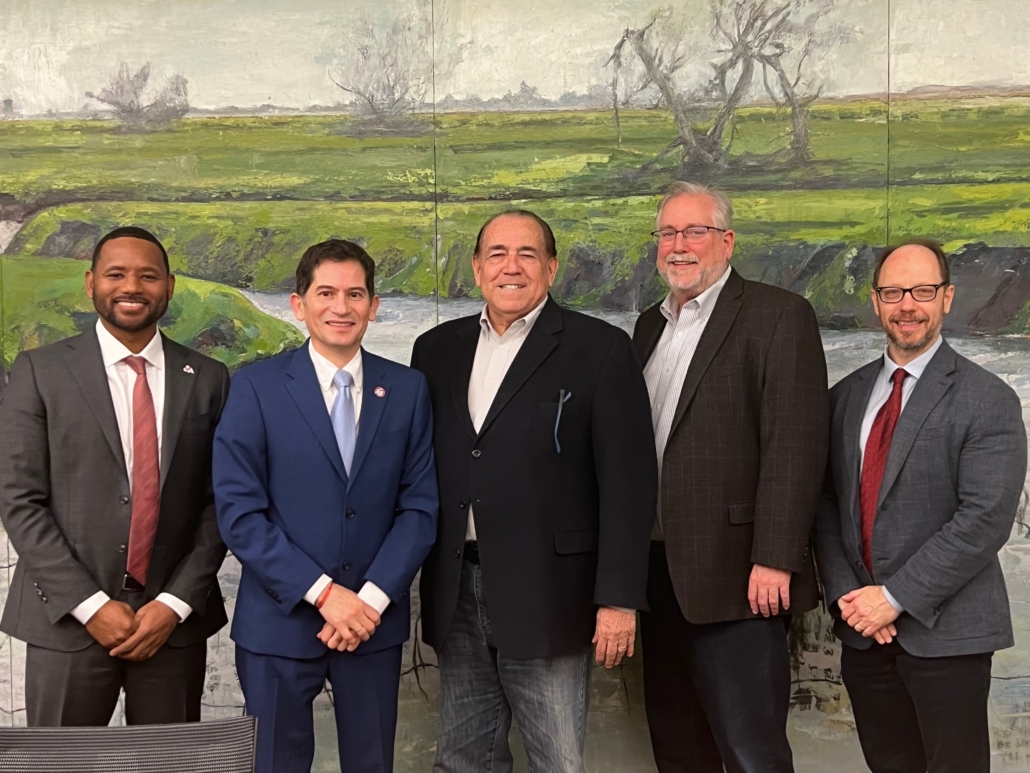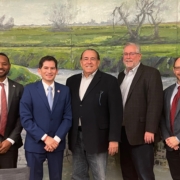
Fresno State, a founding CVHEC member, joined CVHEC’s historic Central Valley Transfer Project in January with (from left): Dr. Kent Willis, vice president of Fresno State Student Affairs and Enrollment Management; University President Saúl Jiménez-Sandoval; Dr. Benjamin Duran, CVHEC executive director; Tom Burke, CVHEC regional coordinator; and Dr. Sergio La Porta, associate dean of the Fresno State College of Arts and Humanities.
Fresno State joins in transfer ‘centerpiece’ with
11 CVHEC community colleges, 3 CSUs, UCMerced
The Central Valley Transfer Project is now partnered with the region’s three California State University campuses after Fresno State signed on in January joining Bakersfield and Stanislaus in the historic Central Valley Higher Education Consortium initiative designed to open new doors for students’ successful transfer from community college.
Along with founding partner University of California, Merced, this means the valley’s four public institutions of higher education are working in unison with 8 community colleges currently through CVHEC’s project using the groundbreaking Program Pathways Mapper software. The project has also gained the full support of the California Community College Chancellor’s Office.
The community colleges already in the CVTP, with several more expected to sign on this year, are: Bakersfield College, Clovis Community College, Madera Community College, Merced College, Porterville College, Reedley College, West Hills College-Coalinga and West Hills College-Lemoore.
The Transfer Project is also expanding participation in the north end of the Central Valley with Modesto Junior College, Columbia College and San Joaquin Delta College scheduled to begin onboard this spring for a total of 11 community college partners said Stan Carrizosa, CVHEC regional coordinator and consortium lead for the project.
All Transfer Project partners are members of the consortium with their respective chancellors and presidents serving on the CVHEC Board of Directors.
“The Transfer Project is now a centerpiece for students to both enter and transfer from community college to their four-year universities,” said Dr. Benjamín Durán, CVHEC executive director. “We are excited to share this latest progress of the project which has been featured statewide and nationally at conferences such as the Community College League of California and Complete College America.”
He added, “This innovative approach is the only one in the state that includes a University of California campus collaborating with partner California State University and community colleges in establishing transfer pathways for Central Valley students to get them to and through college in a timely manner.”
Dr. Saúl Jiménez-Sandoval, Fresno State president and CVHEC board member, said, “I’m proud that Fresno State will be a dynamic partner in the Central Valley Transfer Project, as this pathway will empower community college students to become visionary Bulldogs.”
The Fresno State agreement was finalized Jan. 17 between Durán and President Jiménez-Sandoval, with Tom Burke, CVHEC regional coordinator and Transfer Project team member; Dr. Kent Willis, vice president of Enrollment Services; and Dr. Sergio LaPorta, associate dean of the College of Arts and Humanities.
At CVHEC’s Higher Education Summit last fall, CCC Chancellor Sonya Christian announced that the statewide system has designated the Transfer Project as a demonstration project as set forth in her Vision 2030 for all California community colleges. The Transfer Project’s participating community colleges are serving as the pilot campuses with plans to implement statewide.
Carrizosa said the state budget continues to support and fund the onboarding costs for all community colleges to subscribe to the Program Pathways Mapper.
Established in 2021 with UC Merced, Merced College and Bakersfield College, the project is designed to open new doors for students to successfully transfer from community college with its Program Pathways Mapper, Carrizosa said.
He said the Program Pathways Mapper — a public facing, internet-based app that can be downloaded and accessed by the public software platform — provides unprecedented ease of access for students, counselors, advisors and parents much more so than other existing platforms.
“There are no typical requirements for access to PPM such as other internal college systems like Degree Works, Assist.Org and the CSU Transfer Planner,” he said. “These are all course tracking systems but in order to use them, students need to be successfully enrolled in college and have a student email address or other form of login to try and plan. Through PPM students simply upload the public PPM app to their devices and have immediate access.”
Carrizosa said the PPM helps simplify the transfer planning process which can be the most difficult task for many students.
“In much of our Central Valley region, as many as seven out of 10 incoming college freshmen will be first generation students to attend college,” he said. “Research shows that the most difficult task for them is often the application process itself and completing the required steps for enrollment. Systems like Degree Works and others do nothing to remove this common barrier because these systems cannot be accessed until a student successfully enrolls.”
He explained that a high school student can start the Transfer Project journey as a junior or senior by enrolling in college dual enrollment courses enabling them to complete their transfer level English and Math courses while still in high school. These units roll up with them as they enter community college and track the completion of their lower division requirements for their Associate Degree for Transfer in their chosen major via PPM.
“Students can easily select a community college they wish to attend and a major they want to pursue and the lower division courses required are sequentially laid out for them through the Program Pathways Mapper software.”
In addition, the PPM then links those lower division courses to an upper division institution of the student’s choice and shows a clear sequence of upper division courses needed to complete the degree, Carrizosa added.
“The PPM contains clear and accurate information directly from course catalogues from all participating colleges,” Carrizosa said. “The Central Valley Transfer Project is becoming an alternative continuum of courses to the traditional high school A-G or Career Technical Education continuums and is unprecedented in the state’s community college system. We call it ‘The Central Valley Way!’”
“Through the use of PPM, students complete exactly what is required of them to successfully transfer to their four-year university and they follow PPM through their last two years to degree/certificate completion,” Carrizosa said.
Baseline data results also demonstrate the promise that PPM delivers in the Transfer Project.
In a sample of 5,000 incoming freshmen to Bakersfield College in 2022 the students using the PPM increased their “percentage of on-path course completion” to over 80 percent which also closed the equity gap in this statistic for ethnic minority students when compared to their white counterparts, Carrizosa said.
“The same sample showed students using the PPM reduced the ‘number of units-to-degree’ from an average of 87 down to 67,” he added.
The project is now gearing up to expand the partnership with the College Bridge Math Project and to onboard community colleges from the northern region of the Central Valley.
For more information about the CVTP, contact Carrizosa at centralvalleyhec@gmail.com.
CVHEC media inquiries: Tom Uribes – cvheccommunications@mail.fresnostate.edu or text 559.348.3278.
Fresno State media inquiries: PIO Lisa Bell – lbell@csufresno.edu.
See:
· Pilot CVHEC/UC Merced Transfer Project improves process for students
· CVHEC Web Site Feature: Transfer Project
· Historic Transfer Project spurs statewide movement to increase transfer rates
· HIGHER ED NEWS: College Bridge to expand Math Bridge; CVHEC Transfer Project
• A-G

